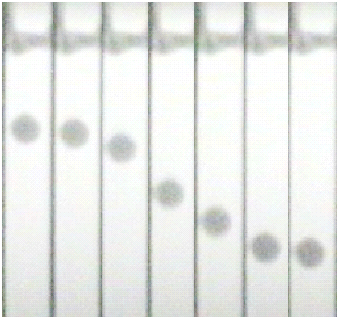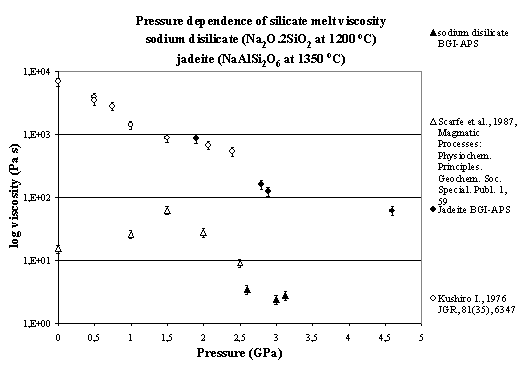

In an effort to constrain the effect of pressure on the viscosity of depolymerised silicate melts relevant to the Earth's mantle, a high-pressure, in-situ falling sphere technique has been used in conjunction with synchrotron X-ray imaging. Because the entire path of the falling sphere was recorded on video, changes in velocity with descent could be observed and calculated. The initial acceleration and final deceleration were discounted leaving only the terminal velocity necessary for the calculation of viscosity using Stoke's Law. For liquids of low viscosity, such as depolymerised silicate melts, this visual technique is essential in extracting accurate viscosity data.
In this study, three compositions covering a range of structural polymerization were investigated: diopside (CaMgSi2O6), sodium disilicate (Na2O.2SiO2) and jadeite (NaAlSi2O6). The experiments were carried out using a DIA-type multianvil apparatus in a 250 tonne hydraulic press at the GSECARS bending magnet beamline at the Advanced Photon Source (ANL, Illinois, USA). The press is designed to accommodate a cubic sample assembly. At pressure, the gap between the anvils allowed the central part of the capsule to be exposed to the X-ray beam. The X-ray absorption contrasts between Pt sphere and silicate melt were converted into visible-light images and recorded online through a video camera (Fig. 3.5-2).
 |
Fig. 3.5-2: Sequential images of the falling sphere (Pt, 200 µm in diameter) in Na2O.2SiO2 liquid at 3 GPa and 1400°C. The sphere reached the bottom of the capsule in 0.8 s. |
The preliminary work shows that this technique and assembly can be used to determine viscosities at temperatures up to 2000°C and pressures up to 5 GPa. The results for sodium disilicate and jadeite are consistent with previous literature data and extend the pressure range of viscosity determinations up to 3 GPa and 4.5 GPa, respectively (Fig. 3.5-3). High super-liquidus temperatures and a low viscosity caused convection in the diopside liquid, affecting the descent of the sphere. Modification of the sample assembly to reduce thermal gradients and efforts to attain higher pressure are presently being pursued.
 |
Fig. 3.5-3: Results for jadeite and sodium disilicate liquid viscosity measurements using high pressure, in-situ, falling sphere viscometry with synchrotron radiation imaging. |

Tel: +49-(0) 921 55 3700 / 3766, Fax: +49-(0) 921 55 3769, E-mail: bayerisches.geoinstitut(at)uni-bayreuth.de
 Previous page
Previous page